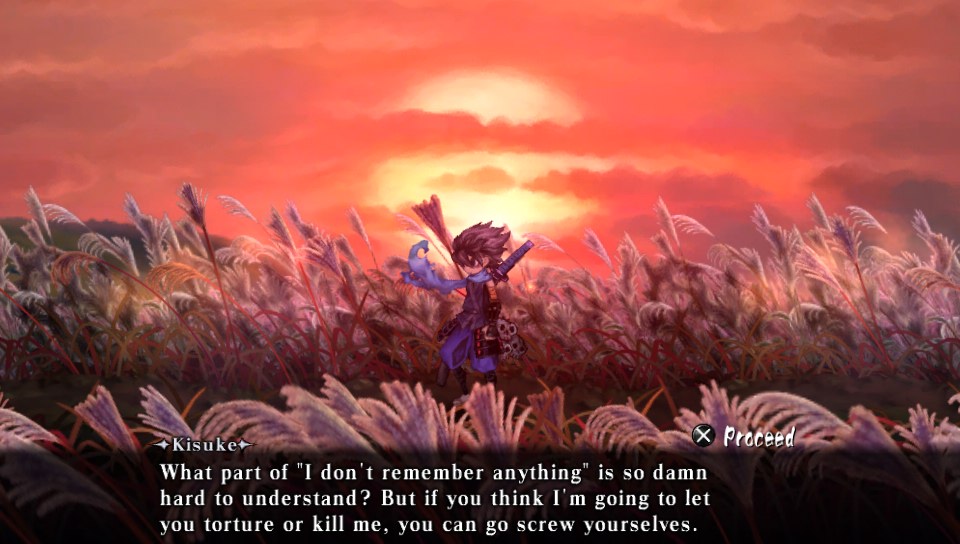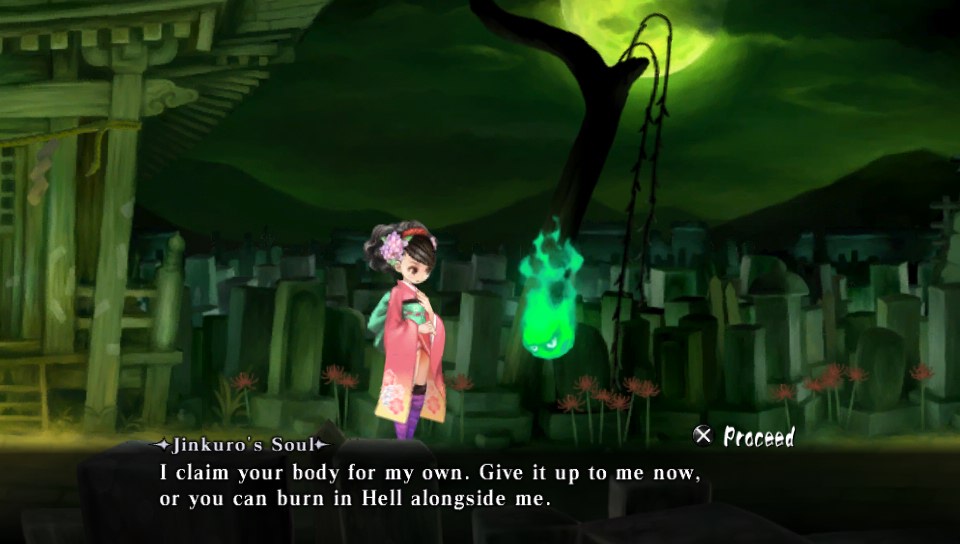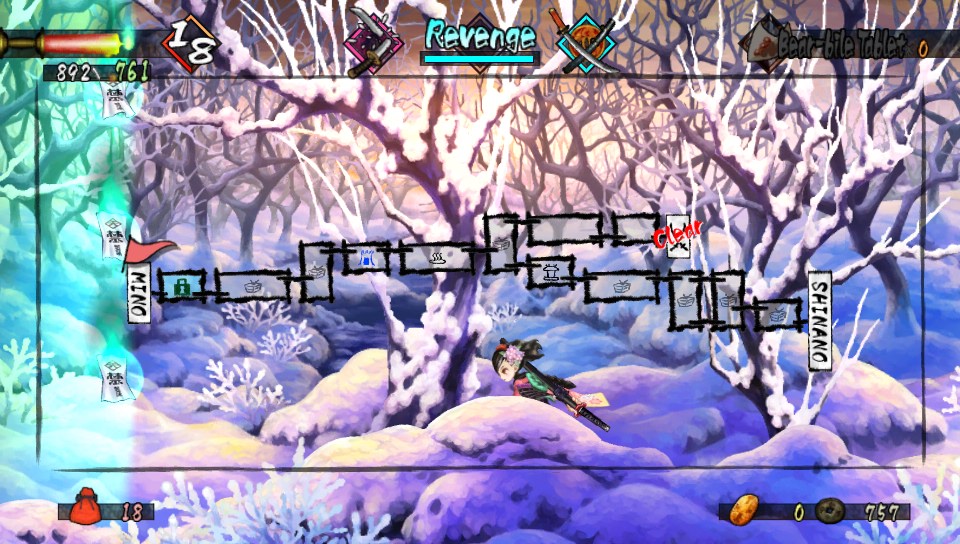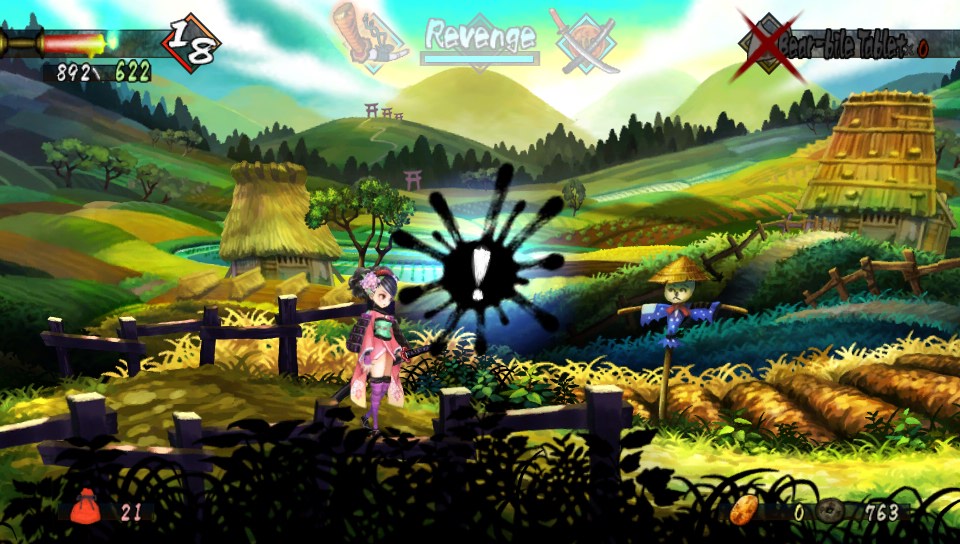Publisher: Aksys Games
Developer: Vanillaware
Medium: Digital Download
Players: 1
Online: N/A
ESRB: T – Teen
Okay, roll call: who played Muramasa when it was called The Demon Blade? No? To be clear, it was a Wii game at the time. Published by Ignition… released in 2009…
There was probably a reason that those who played it were so smitten with Muramasa– and not just because it didn’t force motion controls onto anyone. A frenetic hack-n-slash game, Muramasa bears the Vanillaware mark of modernizing 2D gameplay from a 16-bit era, while removing the line between game sprites and concept art. If anything, this type of gameplay is suited more to the hardware of the Vita than any other console on the market, considering that the fidelity of Muramasa’s assets when coupled with traditional gameplay made for a confusing home on the Wii when we had two nice HD consoles sitting around. If it weren’t for the critical acclaim that supported Muramasa back in the day, it would almost do better for the port to be talked about as a brand-new Vita exclusive.
We may as well pretend that this is Muramasa’s original release, since the visually-striking action game can be reason enough to own a Vita. Not only does it look fantastic on the OLED screen, but with the benefit of being a mid-life home console title, doesn’t find itself light on content.
The game is broken in two parts between protagonists Momohime and Kisuke; respectively, a girl-out-of-body tale and a fugitive with amnesia thing. Since they both handle basically the same in combat, deciding whose journey to sink time into is really a matter of interest in the individual storylines– a convenience made more accessible by the designated ‘files’ for tracking asynchronous progression on each half. This gives players the flexibility to hop in and out of both character’s campaigns without forcing one storyline to have a certain amount of progression before the other will advance.
On the other hand, the ability to forge weapons would advise that players approach each story in tandem, allowing for the combination of blades from each character’s path, accessing some of the cooler weapons in the creation tree.
Muramasa’s gameplay is as-mentioned, quick and chaotic. Players have up to three blades on-hand for swapping between, alongside a dozen or so ways of cutting down enemies. On top of this are magic and special attacks, as well as an area attack when changing blades in combat, which lays the groundwork for combat to turn into a free-for-all grindhouse of coloration and violence. The variations of attack in combination with onscreen mayhem bring life not just to an action game, but seem to wake up the Vita’s screen with beautiful animation and visual effects.
And then there are the massive enemies that you’ll encounter in a boss fight, just to keep the visual splendor at an all-time animated high.
Outside of combat are sequential areas that may or may not contain enemies, since battles are mostly random encounters. Traversal is as quick as the characters are light-footed, which on the Vita’s analog sticks feels great to navigate the environment with. As a platformer, there are a few hidden secrets and magic orbs scattered in precarious places, and it’s a joy to move throughout the environment. The always-helpful onscreen map is back as well, with various options of how much space it resides within.
Aside from the typical button remapping for new hardware, including the addition of a standalone jump button (it was pressing up on the D-pad in its original form), and the obvious visual adaptation to a higher-resolution 16:9 screen, Muramasa: Rebirth boasts an entirely new localization from what the Wii release featured. Aksys put a lot of work into re-writing the localization, which now appears to be truer to the Japanese text, if the additive text is anything to go by. Characters seem to have about three times more to say than ever before, although being so verbose seems to drag down the pacing of an otherwise breakneck pace in action.
It’s unfortunate that aside from broad strokes, the story in Muramasa is pretty ho-hum; however, it could be considered true to the echo of the 2D heyday that story was taking the furthest backseat to gameplay and visuals. In no xenophobic way do I mean this, but an English dub would have almost breathed some life into Muramasa’s story, with the amount of writing players will face. Not only is the story losing me at any given point, but I don’t even have a way to leave my brain shut off and let someone read it to me. If the action is going to be mindless, then at least the writing could have been more concise to go along with it.
Eventually, we’re also suppose to see around four DLC characters to join the cast of playable protagonists; all with their own playstyles. Without any word on when this will be live, it’s hard to call this a bullet point on a list of reasons to commit to Muramasa, except that there’s something extra coming at some point in the future. For now at least, there are PSN trophies to collect.
Whether or not you played Muramasa: The Demon Blade, there’s a good reason to take it for a spin on the PS Vita. The port at least delivers an astonishing look at what the hardware is capable of in a 2D space, and tempts the thought of its predecessor, Odin Sphere, someday seeing a life on Sony’s handheld machine. Muramasa: Rebirth seems to find itself much more at home on the Vita, and can be called an essential title in anyone’s collection. It’s not without faults, however, as the new localization brings an unwanted focus to the dull story, and the lengthy campaigns can leave the title feeling overall long in the tooth. Despite this, it’s more aptly considered Muramasa+; a port that’s slightly more recommended than whatever people had to say about the Wii release.






